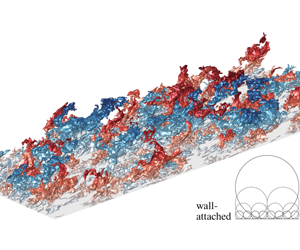Published online by Cambridge University Press: 18 December 2019

The three-dimensional clusters of streamwise velocity fluctuations ( $u$) in turbulent boundary layers (TBLs) are explored from the perspective of the attached-eddy model, which provides a basis for understanding the asymptotic behaviours of high-Reynolds-number wall turbulence in terms of coherent structures. We extract the
$u$) in turbulent boundary layers (TBLs) are explored from the perspective of the attached-eddy model, which provides a basis for understanding the asymptotic behaviours of high-Reynolds-number wall turbulence in terms of coherent structures. We extract the  $u$ clusters from the direct numerical simulation data of a TBL subjected to an adverse pressure gradient (
$u$ clusters from the direct numerical simulation data of a TBL subjected to an adverse pressure gradient ( $\unicode[STIX]{x1D6FD}=1.43$). For comparison, the direct numerical simulation data of a zero-pressure-gradient TBL are included. The identified structures are decomposed into attached self-similar, attached non-self-similar, detached self-similar and detached non-self-similar motions with respect to the minimum distance from the wall (
$\unicode[STIX]{x1D6FD}=1.43$). For comparison, the direct numerical simulation data of a zero-pressure-gradient TBL are included. The identified structures are decomposed into attached self-similar, attached non-self-similar, detached self-similar and detached non-self-similar motions with respect to the minimum distance from the wall ( $y_{min}$) and height (
$y_{min}$) and height ( $l_{y}$). The attached structures (
$l_{y}$). The attached structures ( $y_{min}\approx 0$) are the main energy-containing motions and carry approximately half of the streamwise Reynolds stress and the Reynolds shear stress in the logarithmic and outer regions. The sizes of the attached self-similar structures scale with
$y_{min}\approx 0$) are the main energy-containing motions and carry approximately half of the streamwise Reynolds stress and the Reynolds shear stress in the logarithmic and outer regions. The sizes of the attached self-similar structures scale with  $l_{y}$, and their population density has an inverse-scale distribution over the range
$l_{y}$, and their population density has an inverse-scale distribution over the range  $0.4\unicode[STIX]{x1D6FF}<l_{y}<0.58\unicode[STIX]{x1D6FF}$ (
$0.4\unicode[STIX]{x1D6FF}<l_{y}<0.58\unicode[STIX]{x1D6FF}$ ( $\unicode[STIX]{x1D6FF}$ is the 99 % boundary layer thickness). They also contribute to the logarithmic variation of the streamwise Reynolds stress and to the presence of the
$\unicode[STIX]{x1D6FF}$ is the 99 % boundary layer thickness). They also contribute to the logarithmic variation of the streamwise Reynolds stress and to the presence of the  $k_{z}^{-1}$ region in the pre-multiplied energy spectra (
$k_{z}^{-1}$ region in the pre-multiplied energy spectra ( $k_{z}$ is the spanwise wavenumber), i.e. these structures are universal wall motions in the logarithmic region. The tall attached structures with
$k_{z}$ is the spanwise wavenumber), i.e. these structures are universal wall motions in the logarithmic region. The tall attached structures with  $l_{y}=O(\unicode[STIX]{x1D6FF})$ are non-self-similar and responsible for the enhancement of the outer large scales under the adverse pressure gradient. They extend beyond
$l_{y}=O(\unicode[STIX]{x1D6FF})$ are non-self-similar and responsible for the enhancement of the outer large scales under the adverse pressure gradient. They extend beyond  $6\unicode[STIX]{x1D6FF}$ in the streamwise direction and penetrate deeply into the near-wall region, which is reminiscent of very-large-scale motions or superstructures. The detached self-similar structures (
$6\unicode[STIX]{x1D6FF}$ in the streamwise direction and penetrate deeply into the near-wall region, which is reminiscent of very-large-scale motions or superstructures. The detached self-similar structures ( $y_{min}>0$ and
$y_{min}>0$ and  $l_{y}>100\unicode[STIX]{x1D708}/u_{\unicode[STIX]{x1D70F}}$) are geometrically isotropic and mainly arise in the outer region, whereas the sizes of the detached non-self-similar structures (
$l_{y}>100\unicode[STIX]{x1D708}/u_{\unicode[STIX]{x1D70F}}$) are geometrically isotropic and mainly arise in the outer region, whereas the sizes of the detached non-self-similar structures ( $y_{min}>0$ and
$y_{min}>0$ and  $l_{y}<100\unicode[STIX]{x1D708}/u_{\unicode[STIX]{x1D70F}}$) scale with the Kolmogorov length scale. Here,
$l_{y}<100\unicode[STIX]{x1D708}/u_{\unicode[STIX]{x1D70F}}$) scale with the Kolmogorov length scale. Here,  $\unicode[STIX]{x1D708}$ is the kinematic viscosity and
$\unicode[STIX]{x1D708}$ is the kinematic viscosity and  $u_{\unicode[STIX]{x1D70F}}$ the friction velocity. The present study provides a new perspective on the analysis of turbulence structures in the view of the attached-eddy model.
$u_{\unicode[STIX]{x1D70F}}$ the friction velocity. The present study provides a new perspective on the analysis of turbulence structures in the view of the attached-eddy model.